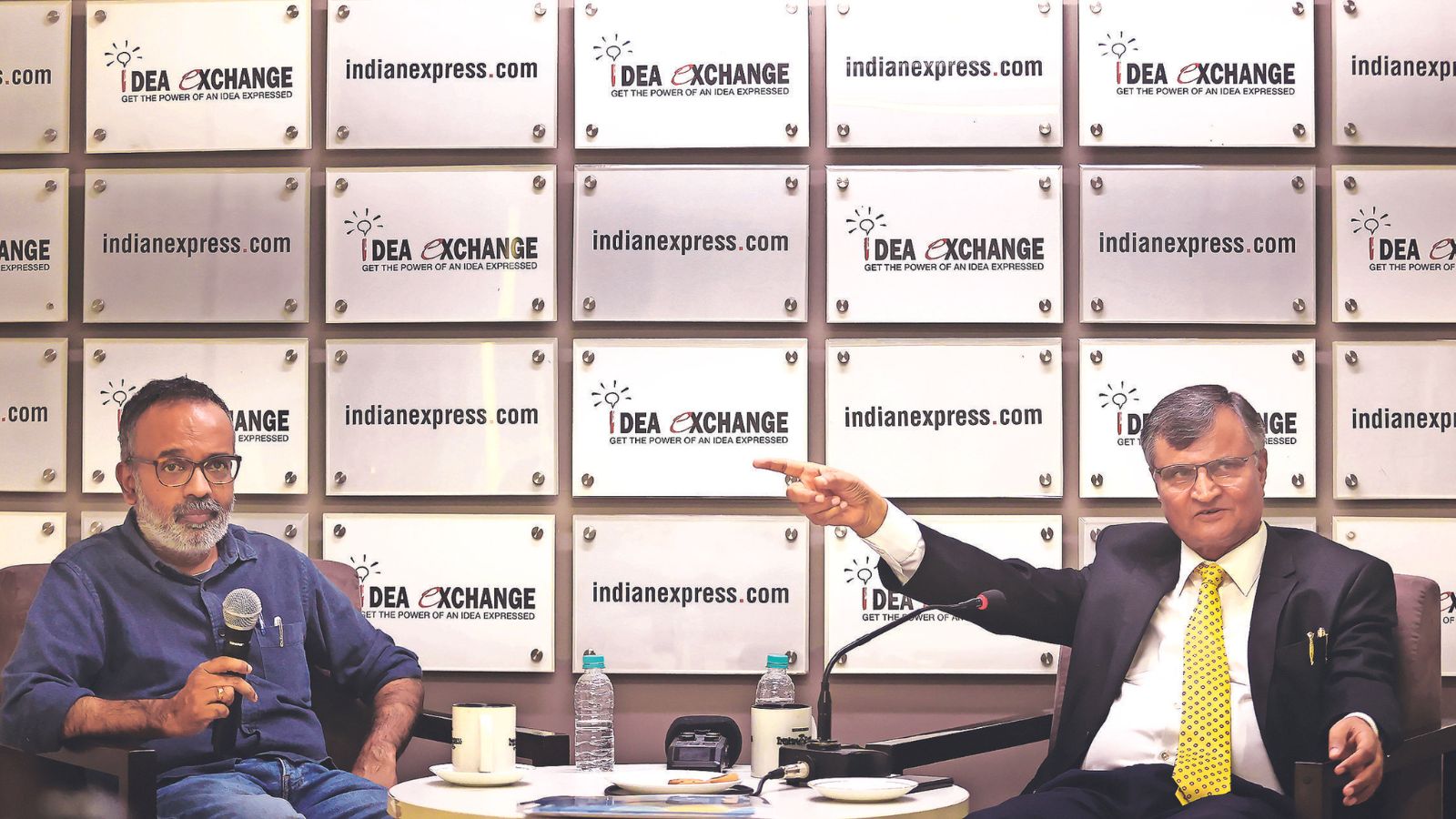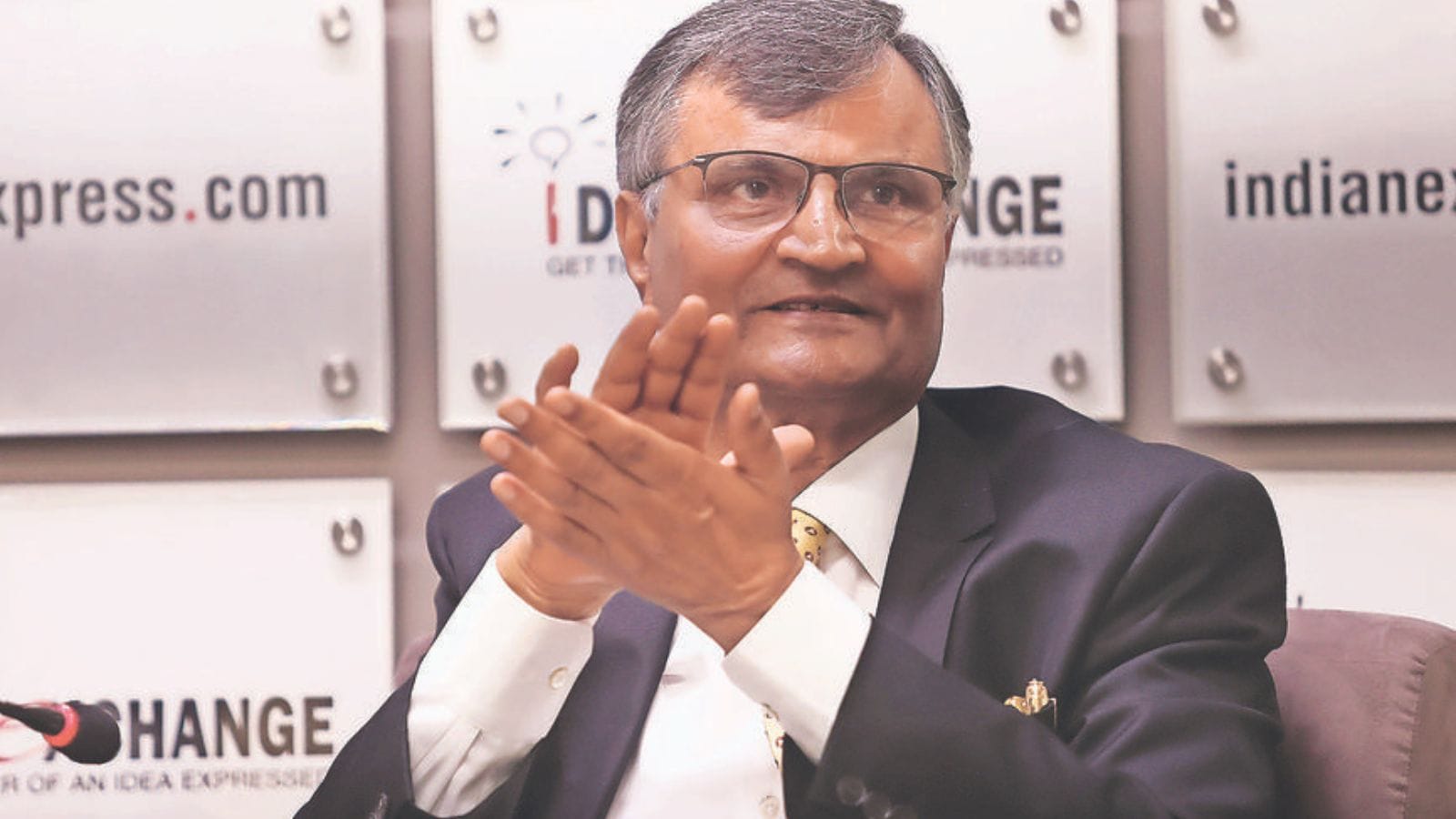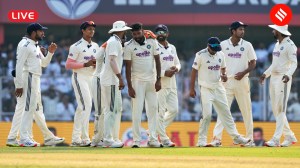Ramesh Chand at Idea Exchange: ‘A sustainable solution for stubble is to create a market for paddy straw, convert waste to wealth’
"I believe that in the next six years or so, a proper market for stubble will be created," Niti Aayog member Ramesh Chand said.
 "Whatever we are witnessing at a world level is a temporary situation. It’s not that the world is facing a food shortage. There are many reasons why world prices of rice and other commodities are moving up — disruptions to food movement, transport cost, risk, insurance and many other things," Ramesh Chand said. (Express photo by Praveen Khanna)
"Whatever we are witnessing at a world level is a temporary situation. It’s not that the world is facing a food shortage. There are many reasons why world prices of rice and other commodities are moving up — disruptions to food movement, transport cost, risk, insurance and many other things," Ramesh Chand said. (Express photo by Praveen Khanna) Ramesh Chand, Member, Niti Aayog, on the reasons for stubble burning and ways to address the problem, creating a circular economy for paddy straw and why agriculture should remain a state subject. The session was moderated by Harish Damodaran, National Rural Affairs and Agriculture Editor, The Indian Express.
Harish Damodaran: The burning issue right now is crop stubble. Data shows that the number of burning incidents has come down substantially but the Supreme Court is not impressed. What exactly is happening?
People say that farmers have a short window (to sow wheat) after harvesting paddy and so we must develop high-yielding but early-maturing varieties. I don’t believe in these solutions. I know farmers who harvest rice as early as mid-October but still burn the straw. We need to find a different solution. The main reason behind the reduced number of cases is the small market that has been created for rice straw. Some compressed biogas plants have come up for using rice straw. The well-known BioCNG plant is in Lehragaga (Sangrur, Punjab), set up by Germany-based Verbio. I was hopeful this technology would spread because you buy paddy straw and produce bio-compressed gas, converting farm fires into energy. The government-owned Gail India will buy whatever bio-gas you are producing from straw within a 20-km radius. Currently, the going rate is probably Rs 65 a kg. It is an attractive proposition. But straw is a high-volume, low-value kind of thing, you require a big space (for storing). So, the first solution that comes to my mind is to create a market for straw.
A second solution has to do with free irrigation. Wherever there is irrigation, it is followed by free or subsidised power for extraction of groundwater. Rice cultivation, then, follows. In Telangana alone, the area under rice cultivation has doubled in the last decade (due to subsidised irrigation). I suggest we let the water supply be metered. You will find that the farmer will make rational use of water and in a few years the area under rice will come down. I did a study on diesel-operated tubewells. In places with electric-operated pump sets with free power, almost the entire area is under paddy. But under diesel-operated farms, you will find maize and other kinds of crops.
Amitabh Sinha: Why has stubble burning gone up so much? How were farmers dealing with straw earlier?
This (burning) appeared after the Punjab government made electricity free for irrigation, which made rice cultivation attractive. Earlier, when the area under paddy was less, farmers kept the stubble after harvesting the crop on one side of the field. With rain, it would decay and get back into the soil; they were not burning it. I belong to Punjab and I had not seen even a single burning till the early ’90s. In areas bordering Himachal Pradesh, hardly any burning happened. This was because there were some packaging industries that bought the rice straw from farmers. Then, there were some Kashmiri (pastoralist) tribes, who come with their livestock. So, because of these reasons, in Punjab’s Kandi belt (in the Shivalik foothills), you hardly found any fires.
Wherever there is irrigation, followed by free or subsidised power for extraction of groundwater, rice cultivation follows. We should put water meters. Let the water supply be metered and the farmer will use water rationally
Amitabh Sinha: What explains the incidences of crop burning in other states also?
The main reason is that farmers want to grow more crops. In some areas of Haryana, in late April, they either want to grow sunflower or some vegetables in the summer. If they leave the stubble there, in the long run, it may be advantageous — the biomass will go back into the soil. But decomposition takes time. So, they quickly want to clear the field. It is human nature to find the easy way out. All countries follow the polluter-pay principle. If people do not fear the law, most people would throw their garbage on the road.
 Ramesh Chand, Member, NITI Aayog, with Harish Damodaran at The Indian Express in Noida. (Praveen Khanna)
Ramesh Chand, Member, NITI Aayog, with Harish Damodaran at The Indian Express in Noida. (Praveen Khanna)
Harish Damodaran: Are you saying there is no compelling reason for farmers not to burn the stubble?
It’s not just that. If you have one-and-a-half months, maybe you require less effort to dispose it of, compared to if you have only a seven-day window. But even if we are able to develop a variety, which gives a window of one month for the next crop, the effect will be very small. We will not be able to get rid of the problem at large (without a polluter-pay policy).
Ritika Chopra: The Supreme Court told the governments of Delhi, Punjab and Rajasthan to ensure that farm fires stop. Do you think that’s practical?
Farmers need to set aside some part of their land to store the stubble. Create a pit, put some urea to decompose it. That’s one way out. But a more sustainable solution is that you create a market for paddy straw and convert a waste-to-wealth circular economy. After you produce bio-gas from straw, whatever remains is bio-slurry and it goes back to the fields. It requires a proactive effort to encourage industries. Many companies took licences, but they have not yet set up (BioCNG) plants. The Punjab CM had said that all the paddy straw will either go to brick kilns, boilers or to the bio-gas and other plants that are coming up.

Kaushik Das Gupta: This year’s data shows stubble burning in Haryana and even Uttar Pradesh is almost negligible. What have they done right?
In the case of Haryana, there are a couple of factors. The total area under rice cultivation is much less compared to Punjab. Secondly, even within rice, Haryana has largely shifted towards basmati. The straw from basmati has less silica and lignin content, because of which livestock can consume that straw. Thirdly, Panipat (oil refinery) is also a good market for bio-ethanol. Haryana also made a serious effort to diversify away from rice.
Kaushik Das Gupta: There seems to have been farm fires even from wheat in April. But it does not show up because pollution wasn’t so bad in Delhi this time.
That’s because there was a wheat shortage. So wheat stubble was selling at a premium. But, even wheat straw is easy to dispose of by burning when there is no accountability and legal enforcement. Also, over time, green fodder has become a strong alternative to dry fodder.
Aakash Joshi: In the cycle of elections, there have been stories about stray cattle being a menace for farmers. With de facto cow slaughter politics and bans, how do you see them affecting the farmers’ economic cycle?
These are not issues settled on economic considerations; they are based on people’s sentiment and matters of faith. I did a report on gaushalas, on how cattle numbers there are swelling, and how we can make gaushalas economically viable. If we move towards the waste-to-wealth model, for paddy straw to get properly decomposed or fermented under anaerobic digestion, you need some microbial activity. For that fermentation to happen, you either use something that the German firm does or maybe you add, say, 20 per cent cow dung. That’s a proposal I had given to make gaushalas more viable through supply of dung.
Liz Mathew: There are many opportunities for farmers to sell stubble, for instance in paper and furniture industries. But there is no consistent effort from the authorities to persuade the farmers.
Yes, this market is emerging now. I believe that in the next six years or so, a proper market for stubble will be created. The market has started offering opportunities for procurement of straw this year and it is only going to expand.
Liz Mathew: Can India afford to reduce rice production, especially at a time when the world is facing food scarcity?
Whatever we are witnessing at a world level is a temporary situation. It’s not that the world is facing a food shortage. There are many reasons why world prices of rice and other commodities are moving up — disruptions to food movement, transport cost, risk, insurance and many other things.
Commodity prices move in cycles. Most of the time, they are either too low or too high — the reason being that every country transfers its own instability into international markets. If India has a surplus, it will say let us export. If India has deficit, it will say let us import. So, you are passing on domestic instability into the international market.
Commodity prices move in cycles. Most of the time, they are either too low or too high — the reason being that every country transfers its own instability into international markets
Story continues below this ad
Vikas Pathak: There is a perception that the procurement of wheat and paddy under MSP has benefited only farmers in Punjab and Haryana. Farmers in many other states complain that they don’t get such assured prices. Is this also leading to over-dependence on wheat and paddy grown in Punjab and Haryana?
Nobody can deny that assured and remunerative price for rice and wheat has caused a shift in cultivation towards these crops. But as far as the concentration of MSP procurement from these two states is concerned, in the last eight to 10 years, there is considerable dilution of this concentration. You will find that the share of Punjab in the central grain pool has been declining. Now, much more rice comes from Chhattisgarh, Madhya Pradesh, Telangana and Andhra Pradesh. Procurement of rice happens from as many as 14 states. It is not only rice and wheat, but there is procurement from other states, of pulses and to a small extent, millets and even oil seeds.
Sandip Das: Do you agree with export bans? We have seen it in onions when farmers were getting some money and now minimum export price restrictions even on basmati rice exports.
The purpose of policy is to balance the interests of different classes. If you’re doing something to reduce export, you affect the interest of the producer, but you safeguard the interest of consumers. In another situation, you find that too much of cheap edible oil is coming into the country. So you put a duty of 30 per cent to keep a check on its import.
Our trade policy has been to maximise the welfare of society and maintain prices within a band. So we need to look at it that way. The farmer or producer should also know that there are situations in which our prices are much higher than the international price. In sugar, for four years, our price was 50 per cent higher than the international price. So, it depends on the situation. International prices are volatile. The best way for a developing country to maintain price stability is to maintain buffer stocks. This stabilisation is very important and India has been working
on that.
 “The purpose of policy is to balance the interests of different classes. If you’re doing something to reduce export, you affect the interest of the producer, but you safeguard the interest of consumers,” Ramesh Chand said. (Express photo by Praveen Khanna)
“The purpose of policy is to balance the interests of different classes. If you’re doing something to reduce export, you affect the interest of the producer, but you safeguard the interest of consumers,” Ramesh Chand said. (Express photo by Praveen Khanna)
Sandip Das: What is the status on doubling of farmers’ income? What is your current assessment?
The last 10 years or more have been good for the agriculture sector. If you look at the elements which go into calculating farmers’ incomes, they have been mostly favourable. The average growth in production during the last 15 years (ending 2021-22) has been over 3.6 per cent.
Also, look at the prices. The terms of trade for agriculture relative to the non-agriculture sector has gone up by 50 per cent during the same period. If you make a global comparison, our share in global agriculture GDP has increased rapidly and we have left China behind in overall agricultural growth in the last 10 years.
Besides, there is a second source of income for farmers — from non-agriculture sources. That is very important. Non-agriculture income accounted for 40 per cent of income of an average farming family in 2012-13 and 47 per cent in 2017-18. When the next survey results (for 2022-23) come, we may see that share crossing 50 per cent. It is because of small farmers, owning one acre or 1.5 acres. Now, almost half of the income is from farm and the other half from non-farm sources.
The last 10 years or more have been good for the agriculture sector in India. If you make a global comparison, our share in the global agriculture GDP has increased rapidly, we have left China behind in agricultural growth
Harish Damodaran: When you look at the experience of China or Vietnam, they’ve moved people from farms to factories. Why has this not happened in India?
I have argued before that the Lewis hypothesis (which theorises the growth of a developing economy through labour transition, from agriculture to industry) is not working in India’s case. India’s growth process bypassed that transition from agriculture to manufacturing and straightaway went to services. Services now accounts for more than 50 per cent of India’s economy and manufacturing is only 16-17 per cent.
It is very strange and probably unique to India that the share of manufacturing in India’s GDP has followed an inverted U-shaped curve. And that decline started after economic reforms; before 1991-92, India’s manufacturing share in Indian economy had reached 20 per cent. So, the Lewis hypothesis is not working despite the same Rs 100 value of output in manufacturing offering two times the employment from that in services. We need to have a different kind of model for India’s development because of the direct transition from agriculture to services and, secondly, urbanisation happening at a very slow rate.

Amitabh Sinha: What is the fate of the farm laws?
For this, it is better to take the state route and help the states to come up with the kind of reforms which they consider suitable for themselves. The model laws are already there, be it agricultural land leasing (from NITI Aayog) or marketing/APMCs (from the Union Ministry of Agriculture). The (Centre’s) farm laws are also there. So wherever a state feels there is a deficiency, I think they should address it and go ahead. But the sustainable way of having growth in agriculture is not in offering different kinds of MSP. We should enable farmers to get the best market price and enable markets to pay the farmer a remunerative, competitive price. Look at how some sub-sectors within agriculture are growing. For instance, fish is growing at 9-10 per cent, poultry at 5-6 per cent, eggs and broiler and milk at 4.5 per cent per year without any kind of MSP. Horticulture is growing at a higher rate compared to rice and wheat. All this because their production is demand driven. So we should make our market send signals to the farmers that this is what is needed on the demand side. Once that happens, you will see that big change in agriculture happen.
Ritika Chopra: NITI Aayog has a lot of indices, and a lot of them were introduced to promote the spirit of cooperative federalism and give states an opportunity to compare their performance across sectors. So first was the health index, and very recently, the water management index. Has there been a rethink on the indices that NITI Aayog initially introduced? Why have these two not been released?
There’s nothing fixed about indices. For instance, when we wanted to create competition among states in agriculture, I created the Agriculture Market Reform index, but I produced it only for one year. NITI Aayog goes for indices to capture attention for a particular period. So, from time to time, when a new thing comes you go for that type of thing. At one time, we promoted ease of doing business, so for some years we did it.
Liz Mathew: Recently, while travelling in Madhya Pradesh, many farmers I met were complaining about low-quality fertilisers and seeds. Are you concerned about this or is it just a local issue?
There are a lot of reports about spurious pesticides and insecticides. In the case of fertilisers and seeds, I don’t think it is a pan-India situation, maybe there are some isolated cases. You see one thing that the media should highlight is that agriculture is basically a state subject. Monitoring the quality of seeds or pesticides is the responsibility of the states.






- 01
- 02
- 03
- 04
- 05

























